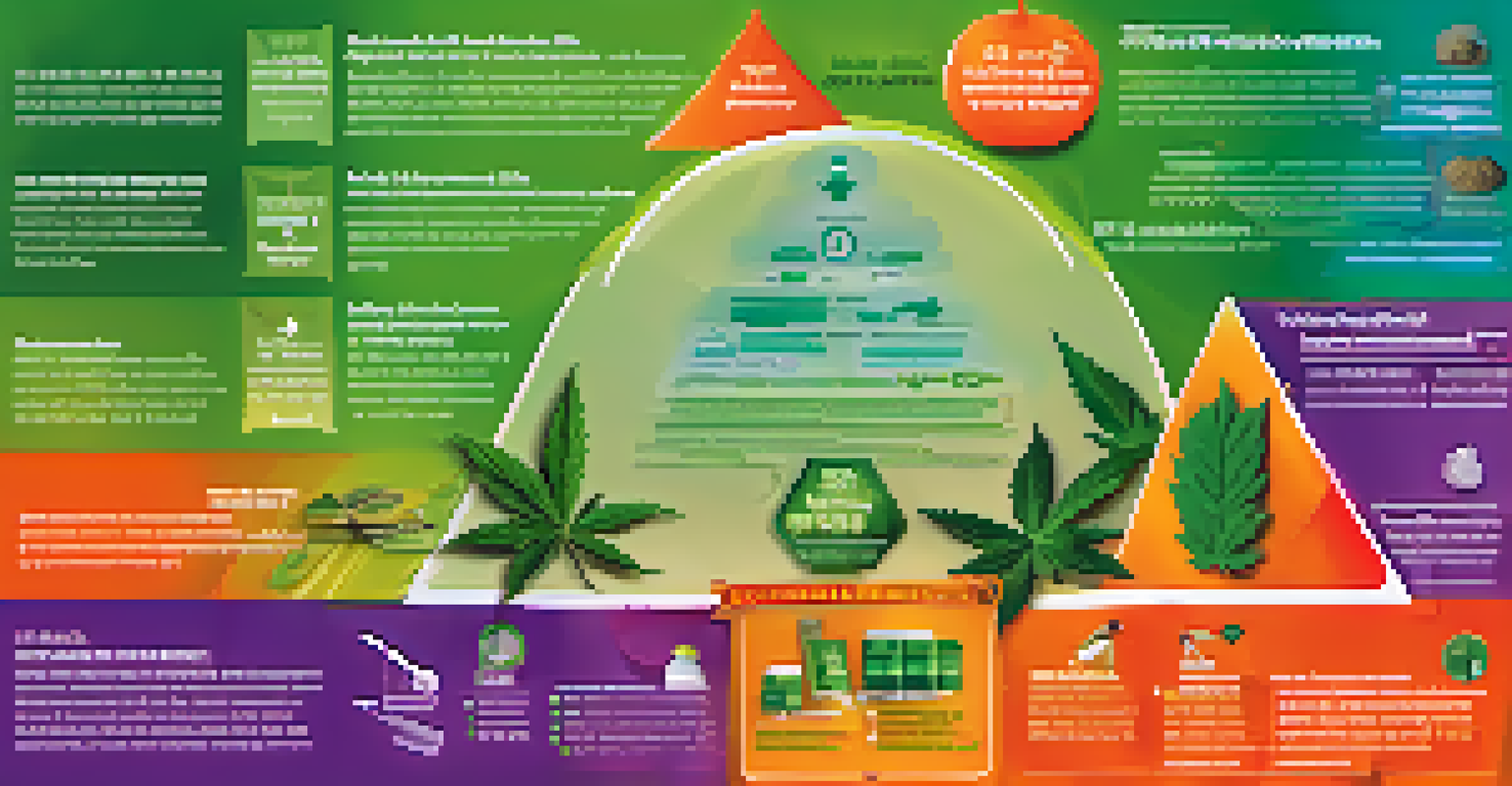Comparing Harm Reduction Approaches: Marijuana vs. Other Drugs

Understanding Harm Reduction: A Brief Overview
Harm reduction is a set of practical strategies aimed at reducing negative consequences associated with drug use. It focuses on minimizing harm rather than solely attempting to eliminate drug use altogether. This approach recognizes that while some people may struggle with addiction, others may use substances recreationally without severe adverse effects.
The opposite of addiction isn't sobriety. It's connection.
One key aspect of harm reduction is its non-judgmental stance, which promotes user safety and well-being. This is particularly important in the context of drug policies that often stigmatize users. By prioritizing health and safety, harm reduction strategies can lead to more effective outcomes for individuals and communities.
Examples of harm reduction strategies include needle exchange programs, supervised consumption sites, and education on safer use practices. These initiatives aim to reduce health risks, such as the spread of infectious diseases or overdose deaths, while also providing support for those who may wish to change their relationship with substances.
Comparing Marijuana Use to Other Drugs
Marijuana is often perceived as a less harmful substance compared to other drugs like opioids, cocaine, or methamphetamine. This perception stems from its lower potential for addiction and less severe health consequences when used responsibly. However, it’s crucial to recognize that marijuana can still pose risks, particularly for vulnerable populations like adolescents or individuals with pre-existing mental health conditions.

In contrast, other drugs, especially opioids, have a higher risk of overdose and a more pronounced impact on physical health. The opioid crisis has highlighted the urgent need for harm reduction strategies, as many users face life-threatening risks from their substance use. As we weigh marijuana against these substances, it's essential to consider not just the potential harms, but also the context in which these drugs are used.
Harm Reduction Prioritizes Safety
Harm reduction focuses on minimizing the negative consequences of drug use rather than eliminating it entirely, promoting user safety and well-being.
Understanding the differences in how marijuana and other drugs affect the body can inform harm reduction approaches. For instance, while marijuana can lead to psychological dependence, opioids can result in physical dependence and withdrawal symptoms that are often debilitating. This distinction can help tailor harm reduction strategies to the specific needs of users, ensuring they receive appropriate support.
Harm Reduction Strategies for Marijuana Users
When it comes to marijuana, harm reduction strategies can include education on dosage, methods of consumption, and understanding individual tolerance levels. For example, users may benefit from guidance on how to consume cannabis in ways that minimize health risks, such as opting for edibles over smoking. This knowledge can empower users to make informed choices about their consumption.
Harm reduction is not about condoning drug use, it's about reducing the harm that drug use can cause.
Another important aspect is promoting awareness around the legal status of marijuana, which varies greatly by region. Educating users about their rights and local laws not only helps them stay safe but also reduces anxiety and stigma associated with use. This can also foster a more informed community dialogue around marijuana as a legitimate substance.
Finally, providing access to resources such as counseling or support groups can enhance the overall effectiveness of harm reduction for marijuana users. These resources can help individuals navigate their relationship with cannabis, whether they wish to cut back, quit, or simply learn more about safe use. By offering these avenues for support, we can create a more comprehensive harm reduction framework.
Harm Reduction Approaches for Other Drugs
When addressing harm reduction for other drugs, strategies often include needle exchange programs and supervised consumption sites. These initiatives aim to provide safe environments for users, reducing the risks associated with sharing needles and using substances in unsafe conditions. Such programs have proven effective in decreasing the spread of diseases like HIV and hepatitis C.
Education plays a crucial role in harm reduction for other substances as well. Providing users with information about the risks of overdose, safe consumption practices, and available resources can empower them to make safer choices. For instance, teaching users how to recognize the signs of overdose can save lives, especially in the case of potent substances like fentanyl.
Education is Key to Harm Reduction
Providing education about safe practices and the risks associated with drugs is essential for fostering informed choices and reducing harm.
Moreover, connecting users to support services, such as addiction counseling or medical help, is essential in harm reduction efforts. This holistic approach addresses the underlying issues related to substance use, providing pathways to recovery for those who seek it. Ultimately, harm reduction for other drugs aims to create a supportive environment that prioritizes health and safety.
The Role of Education in Harm Reduction
Education is the backbone of effective harm reduction strategies, whether for marijuana or other substances. By informing users about the risks and safe practices associated with drug use, we can significantly reduce harm. This proactive approach fosters a culture of safety and accountability among users.
For example, educational programs can cover topics like recognizing signs of overdose, understanding drug interactions, and the importance of using substances in moderation. Providing users with this knowledge not only enhances their safety but also encourages responsible use. It's about giving individuals the tools they need to make informed choices.
Furthermore, education can help dismantle the stigma surrounding drug use. When users are educated about the complexities of addiction and harm reduction, it fosters empathy and understanding within the community. This shift in perspective is crucial for creating supportive environments where individuals feel safe to seek help without fear of judgment.
Challenges in Implementing Harm Reduction
Despite its benefits, implementing harm reduction strategies often faces significant challenges. One major obstacle is the lingering stigma associated with drug use, which can hinder community buy-in and support. Many people still view drug users through a lens of judgment rather than understanding, making it difficult to foster a supportive environment for harm reduction initiatives.
Additionally, legal and regulatory barriers can complicate the implementation of harm reduction programs. For instance, supervised consumption sites may face opposition from local governments or communities that fear they will encourage drug use. Overcoming these barriers requires advocacy and education to demonstrate the benefits of harm reduction for public health.
Collaboration Enhances Effectiveness
Working together across various sectors, including policymakers and healthcare providers, is crucial for advancing harm reduction strategies and addressing public health challenges.
Finally, funding for harm reduction initiatives is often limited. Many programs rely on grants or donations, making them vulnerable to changes in funding availability. Ensuring that these essential services remain operational requires persistent advocacy and community support to secure consistent funding.
The Future of Harm Reduction: A Balanced Perspective
As we look to the future, the need for a balanced perspective on harm reduction becomes increasingly clear. Embracing a multifaceted approach that considers the unique characteristics of different substances can lead to more effective strategies. This balance is crucial in addressing the ongoing challenges posed by substance use in our communities.
Encouraging collaboration between policymakers, healthcare providers, and harm reduction advocates is essential for advancing these strategies. By working together, we can create comprehensive frameworks that prioritize public health and safety. This partnership can help bridge the gap between traditional drug policies and innovative harm reduction approaches.

Ultimately, the future of harm reduction will depend on our ability to adapt and respond to the evolving landscape of substance use. By fostering open dialogue, supporting education, and advocating for user rights, we can create a more inclusive and effective harm reduction model that benefits everyone involved.